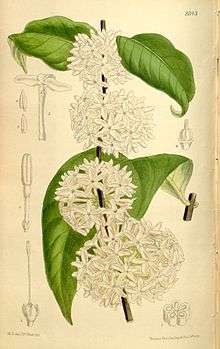Pleiocarpa mutica
| Pleiocarpa mutica | |
|---|---|
 | |
| Pleiocarpa mutica [1] | |
| Scientific classification | |
| Kingdom: | Plantae |
| (unranked): | Angiosperms |
| (unranked): | Eudicots |
| (unranked): | Asterids |
| Order: | Gentianales |
| Family: | Apocynaceae |
| Genus: | Pleiocarpa |
| Species: | P. mutica |
| Binomial name | |
| Pleiocarpa mutica Benth. | |
| Synonyms[2] | |
| |
Pleiocarpa mutica grows as a shrub or small tree up to 7.5 metres (25 ft) tall, with a stem diameter of up to 5 centimetres (2.0 in). Its fragrant flowers feature a white corolla. Fruit is yellow to bright orange with paired follicles, each up to 2 centimetres (0.79 in) long. The plant is found in a variety of habitats from sea-level to 600 metres (2,000 ft) altitude. Local medicinal uses include as a treatment for stomach-ache, kidney diseases, malaria, jaundice and as a laxative.[3] P. mutica is found in Sierra Leone, Liberia, Ivory Coast, Ghana, Nigeria, Cameroon, the Central African Republic, Gabon and the Republic of Congo.[4]
References
- ↑ 1910 illustration from M.S. del., J.N.Fitch lith. - Curtis's Botanical Magazine, London., vol. 136 [= ser. 4, vol. 6]: Tab. 8343
- ↑ "Pleiocarpa mutica". The Plant List. Retrieved 18 August 2013.
- ↑ Medicinal Plants. PROTA. 2008. pp. 468–469. ISBN 978-9-05782-204-9.
- ↑ Search for "Pleiocarpa mutica", World Checklist of Selected Plant Families, Royal Botanic Gardens, Kew, retrieved 18 August 2013
| Wikimedia Commons has media related to Pleiocarpa mutica. |
| Wikispecies has information related to: Pleiocarpa mutica |
This article is issued from Wikipedia - version of the 3/18/2016. The text is available under the Creative Commons Attribution/Share Alike but additional terms may apply for the media files.